Boeing Statistics And Facts 2025 | By Revenue, Trends and Insights
Updated · Nov 03, 2025

Table of Contents
Introduction
Boeing Statistics: Going up there as one of the heavyweights in the sky, Boeing has known turbulence in its most recent years. From safety scares and strikes to enormous financial losses, Boeing had not kept pace with Airbus nor restored its good name. But numbers have a more powerful voice: Boeing’s figures have told both a story of challenge and of resilience.
Consider billions in revenue, thousands of planes on the backlog, and surging deliveries in 2025 to prove how the demand for Boeing’s aircraft is still very much alive. Can Boeing statistics convert this momentum into profits and, once more, take the crown as leader of the aviation arena?
Editor’s Choice
- In 2024, Boeing delivered 348 planes, whereas Airbus delivered 766, widening the gap in global competition.
- Boeing posted net losses of just under US$8bn for the first nine months of 2024, including a staggering US$6.2bn Q3 loss.
- New CEO Kelly Ortberg has announced plans to cut 10 percent of Boeing’s workforce, amounting to 17,000 jobs, to restructure operations.
- In 2024, Boeing increased its R&D expenditures to US$3.8 billion to foster innovation and impose stricter safety standards.
- With orders for more than 6,200 planes, Boeing saw its backlog grow to US$545 billion in Q1 2025, painting a picture of high demand for the future.
- The revenue stood at US$22.7 billion in Q2 2025, soaring by 34.3% on a year-over-year basis, whereas losses were narrowing considerably. 150 jets were delivered in the quarter by Commercial Airplanes, increasing by 63%, while net new orders were taken at 455.
- The Boeing Defense, Space & Security made profits in Q2 2025 with an income of US$110 million against a loss of US$913 million in the same period a year ago.
- The defense backlog rose to US$74 billion, and with 22% orders away from the U.S., it shows its global standing.
- Boeing sets a target for 610 deliveries in 2025, but if the trend continues, it may fall short with a production forecast closer to 530 planes.
Boeing Annual Deliveries
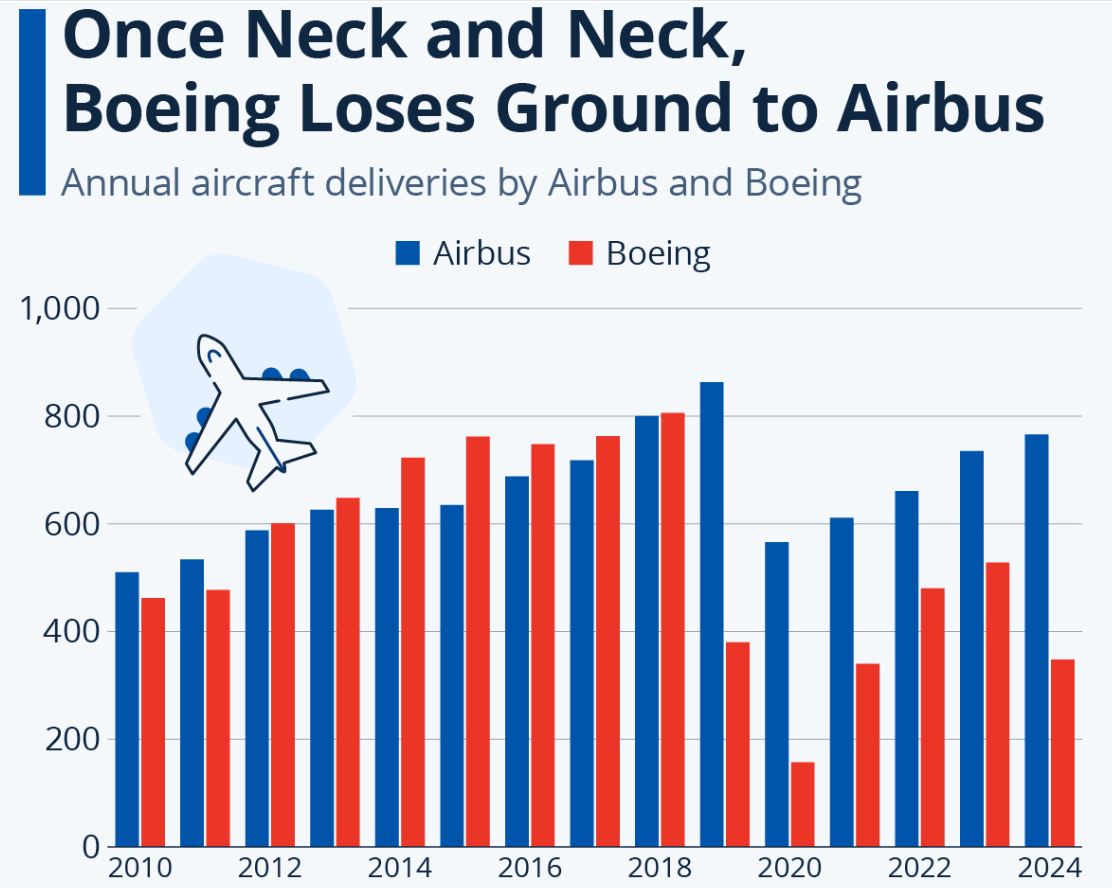
(Source: statista.com)
- As per a Statista report on Boeing statistics, Boeing went through another hard year in 2024 and dropped further behind Airbus in aircraft deliveries.
- Boeing delivered 348 commercial planes, which was 180 fewer than in the previous year, while the number of jetliner deliveries increased on the Airbus side by 31 to 766 plane deliveries.
- The year was eventful for Boeing, starting with a midair incident involving an Alaska Airlines 737 Max 9 when a door plug blew out.
- It was broken by loose bolts on the same aircraft model, according to Alaska Airlines and United Airlines, shortly after.
- More safety issues were coming up over different models, weighing on the company even more.
- More than 33,000 machinists from the US Northwest went on strike between September and November, demanding better wages and benefits, further sending production into a whirl.
- Both Boeing and Airbus had been very close competitors in deliveries up to 2019: the worldwide grounding of the 737 Max 8 for 20 months since both mobilizations had followed two fatal crashes killing 346 individuals.
- Further into losses when the pandemic cut orders by airlines, Airbus has a stronger recovery, whereas Boeing is left behind.
Boeing Net Loss/Earnings

(Source: statista.com)
- On the article of heavy financial losses incurred through 2024, Boeing lost almost US$8 billion net through the first nine months of the year; the whopping US$6.2 billion losses from the third quarter itself are the fourth-worst quarter in the company’s record ever.
- These unfortunate financial results came as the assembly plants, where the strike had been for over five weeks, were temporarily stopped in production.
- Soon after, the workers continued to reject the contract proposal that would have given them almost a 35% pay raise over four years, plus additional contributions to their 401(k) accounts, since their demands were for at least 40% pay raises and the return of pension rights.
- Major modifications are forecast by new CEO Kelly Ortberg, who has alluded to some streamlining of Boeing operations. In the earlier days of October, he unveiled the layoff of some 10% of the workforce, roughly 17,000 jobs, owing to the restructuring exercise.
- This marks the sixth year running the company has suffered an annual net loss, beginning from one set of implications coming on the back of two turbulences caused by crashes of the 737 Max aircraft in 2018 and 2019.
- The crashes led to a worldwide grounding of the aircraft and caused the company to record its very first annual loss in two decades at US$636 million in 2019, a huge drop from US$10.5 billion the year before.
- The pandemic struck and worsened the crisis as Boeing posted losses of nearly US$12 billion in 2020 amid the steep slowdown of the aviation industry, some of which came by 2023.
- However, the year 2024 seems to have brought yet more tribulations in its wake, as safety concerns resurfaced, including the door plug blowing out mid-air in January that temporarily grounded 171 aircraft.
- Amidst all the turmoil, Boeing still maintains a hefty backlog of orders, with 6,259 aircraft on its books by March 2024, which is a hopeful sign for the company if it can navigate production and safety challenges.
Boeing R&D Expenditure
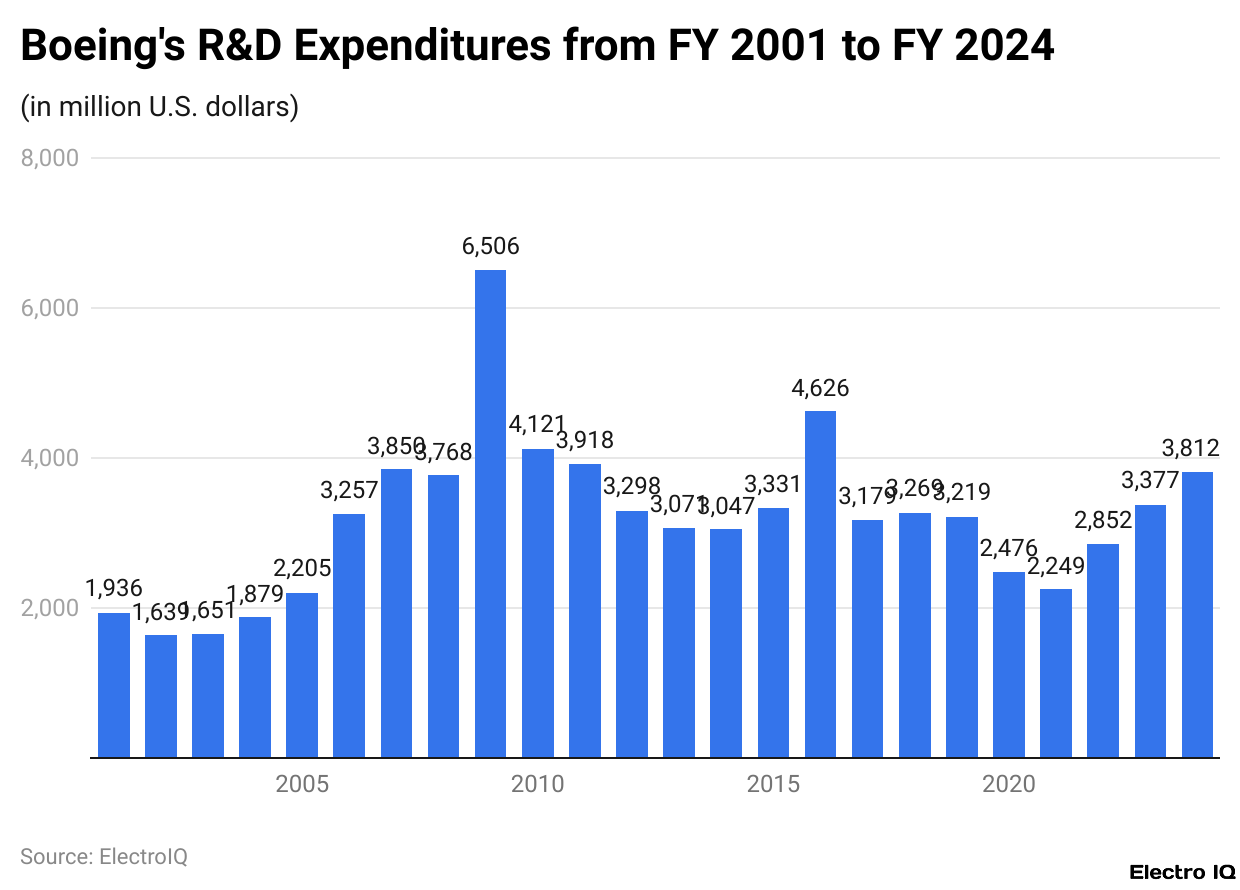
- Boeing raised its research and development expenditures to an amount equal to 3.8 billion dollars in 2024, up from 3.4 billion in 2023.
- This increase is indicative of the whole company’s emphasis on innovation as it works to overcome recent challenges and meet more stringent safety standards.
- Boeing has suffered annual losses for six years in a row, yet it remained one of the world’s most central aerospace companies, often viewed in a global duopoly together with Airbus.
- The U.S. has always been the biggest market for Boeing, with over 54% of total revenue coming from the country in 2024.
- Eventually, for Boeing to develop advanced technologies, restore confidence, and compete with greater strength worldwide, it needs to sustain its R&D investments.
Boeing Total Backlog
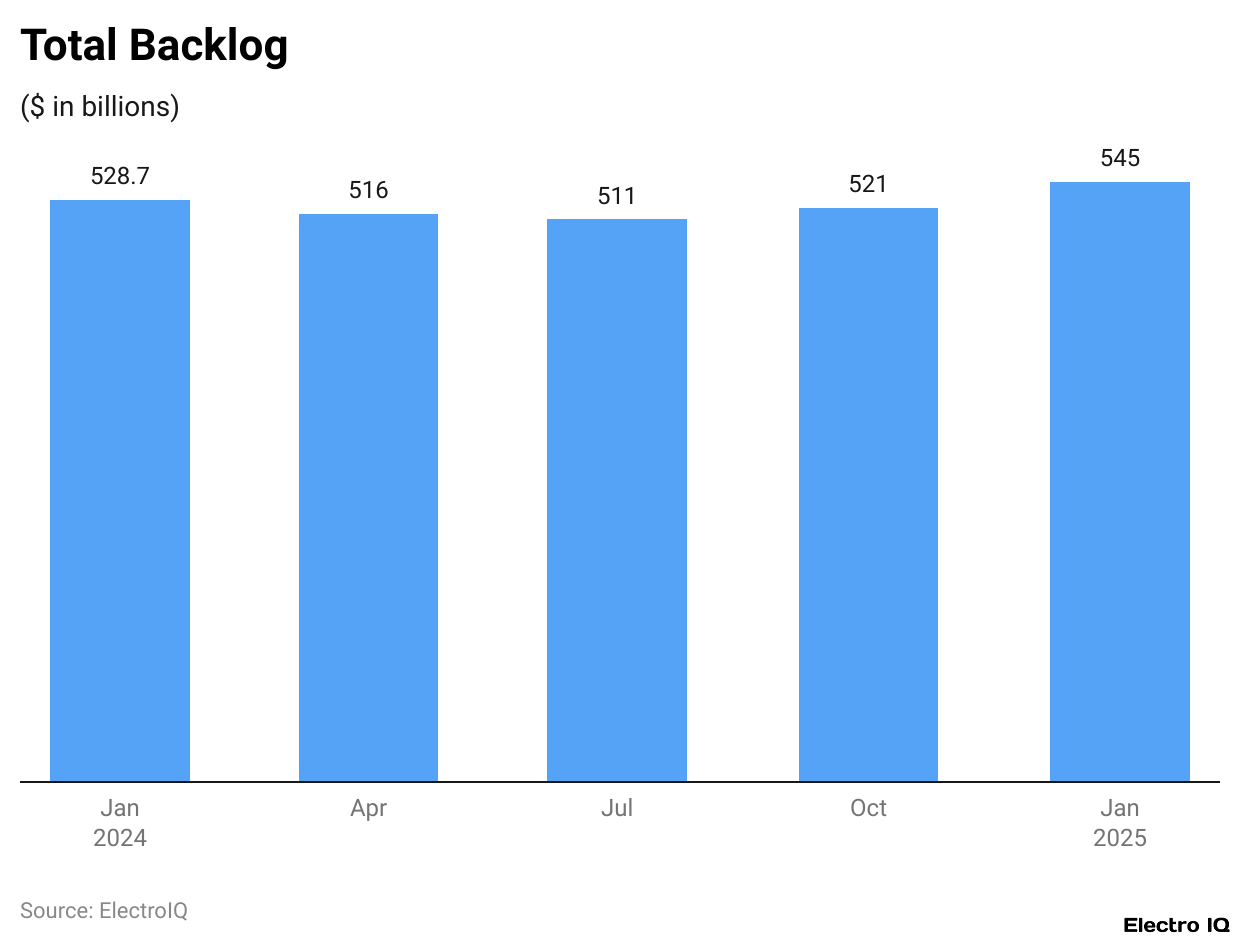
(Reference: alphastreet.com)
- As per Alphastreet, Boeing’s statistics show that Boeing’s total backlog slightly fluctuated throughout 2024.
- It stood at US$528.7 billion in the first quarter but declined to US$516 billion and further decreased to US$511 billion in the second and third quarters, respectively; however, the fourth quarter saw a recovery with the backlog rising to US$521 billion.
- The onset of 2025 saw another increment in demand to the tune of US$545 billion, signaling a potent demand rebirth and a strong pipeline ahead in aircraft orders despite the ongoing crisis experienced by the company.
Boeing Financial Position
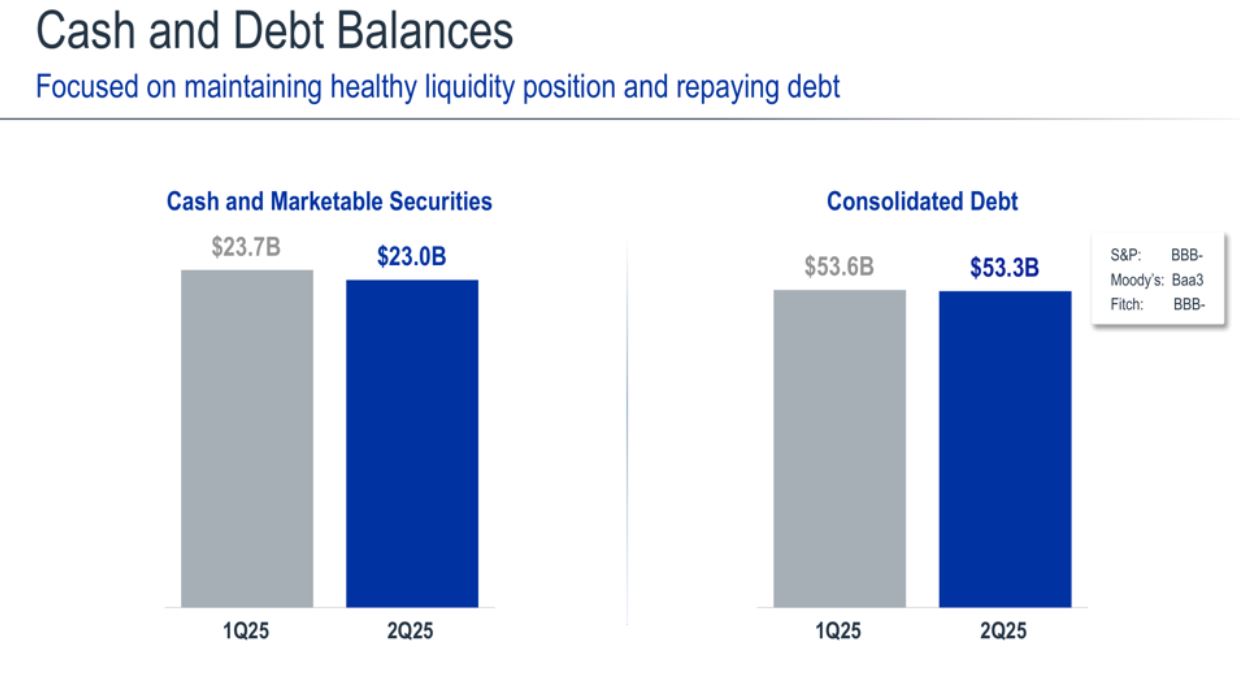
(Source: investing.com)
- At the end of the second quarter of 2025, Boeing held US$23.0 billion in cash and near-cash investments.
- This is slightly lower than the US$23.7 billion held at the end of the previous quarter, meaning that its cash position remained quite stable.
- The company had total debt of US$53.3 billion, a slight decrease from US$53.6 billion at the end of the previous quarter, implying that Boeing had begun paying down debt.
- Credit rating agencies — S&P, Moody’s, and Fitch — continue to rate Boeing’s debt at BBB- or equivalent, which is still investment grade.
- This classification implies that despite heavy indebtedness, Boeing is seen as capable of honoring its obligations.
Boeing Operational Performance
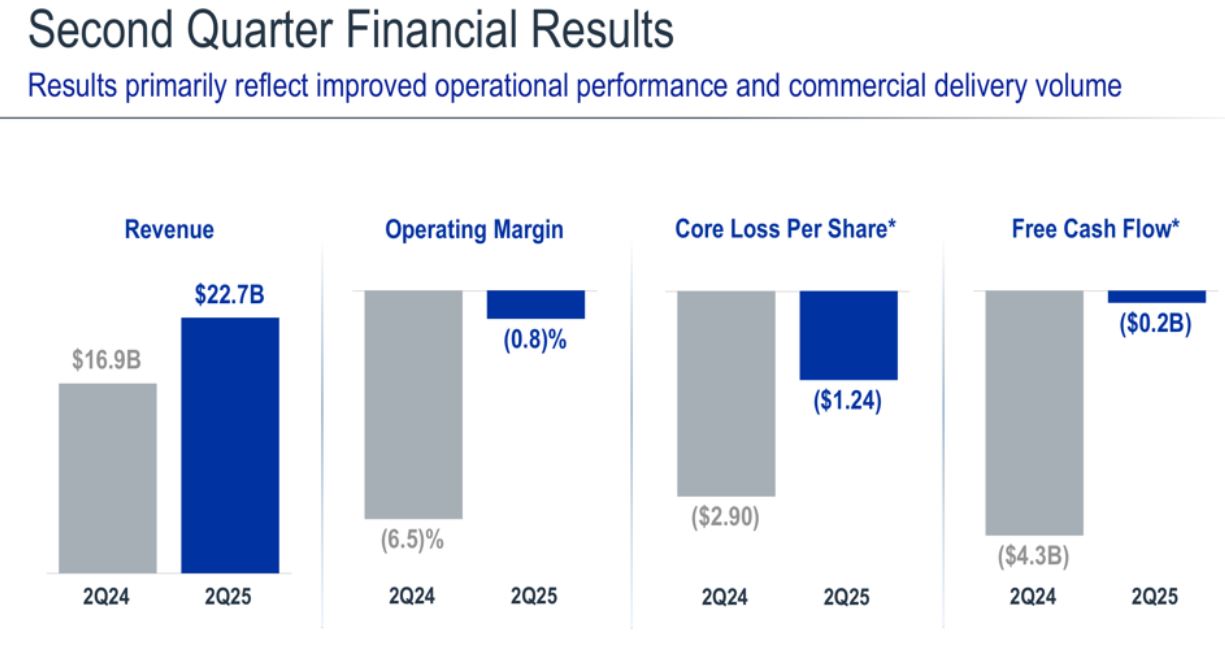
(Source: investing.com)
- In the second quarter of 2025, Boeing recorded revenues of US$22.7 billion, which constitutes an increase of 34.3% from US$16.9 billion for the corresponding quarter of 2024.
- The company’s operating margin, which measures profit or loss as a percentage of sales, also increased.
- Remaining negative at -0.8%, it was better than the year-earlier loss of -6.5%, showing that Boeing is approaching break-even territory.
- Adjusted loss per share from core operations narrowed to -US$1.24 from a much wider loss of -US$2.90 for Q2 2024.
- Free cash flow, representing how much money remains in the coffers after paying expenses and investing in soundboards, also saw a sharp leap: Boeing used only US$0.2 billion this quarter compared to US$4.3 billion in the same quarter last year.
- Together, these numbers show that while Boeing is still losing money, it is losing far less than before and going in the right direction.
Boeing Commercial Planes

(Source: s2.q4cdn.com)
- In 2Q 2025, the Commercial Airplanes division delivered 150 planes, registering an increase of 63% against 92 deliveries during the same period last year.
- Deliveries in the first half stood at 280 against 175 in the first half of 2024, growing by 60%.
- Higher deliveries brought the revenue for the quarter to US$10.9 billion, up 81% from US$6.0 billion a year ago.
- For the first half, revenue increased to US$19.0 billion as compared to US$10.7 billion last year, an increase of 79%.
- The division still posted a loss from operations amounting to US$557 million during the quarter.
- However, it was an improvement from the loss of US$715 million in Q2 2024.
- Operating margins changed for the better to -5.1% from the prior -11.9%; basically, this shows that losses are narrowing as deliveries grow.
- At present, the 737 program is churning out 38 planes a month, and Boeing would want to maintain that through to the year-end, seeking approval later in the year to increase capacity to 42.
- The 787 program is running at seven planes per month.
- On the orders front, the division logged 455 net new orders for the quarter. These big deals included 120 787s and 30 777-9s for Qatar Airways, and 32 787-10s for British Airways.
- At the end of the quarter, Boeing Commercial Airplanes had delivered 150 planes and a backlog of more than 5,900 aircraft, worth about US$522 billion in value.
- Even though it is still under pressure in profitability terms, such a backlog denotes very strong demand going forward.
Boeing Defence, Space And Security

(Source: s2.q4cdn.com)
- During the second quarter of 2025, revenue landed at US$6.6 billion from Boeing’s Defense, Space & Security business, up 10% from US$6.0 billion in the same quarter a year ago.
- Revenue for the half-year amounted to US$12.9 billion, compared to US$13.0 billion for the first half of 2024.
- The division showed profits this quarter, with operating earnings of US$110 million versus a loss of US$913 million in Q2 2024, which turned into an operating margin of 1.7%, from – 15.2% last year.
- Operating earnings for the first half of 2025 totaled US$265 million versus a loss of US$762 million in the first half of 2024, with margins improving from -5.9% to 2.1%.
- This recovery reflects more assured operations in the defense programs. During the quarter, Boeing was awarded a contract from the U.S.
- Air Force to build four T-7A Red Hawk training aircraft, and also commenced ground testing for the first MQ-25 Stingray refueling drone for the U.S. Navy.
- More importantly, 22% of this backlog comes from outside the United States, showing Boeing has a truly global footprint in defense.
Aircraft Usage
- Boeing predicted that 25,700 commercial planes would be needed by airlines in 20 years, and the passenger traffic would increase by about 4.8 percent each year in 2005.
- In those days, planes flew at somewhere about 73% average seat occupancy, whereas today that figure is around 83–84%.
- That extra 10 percentage points translates to an additional 10–20 seats per aircraft without changing the aircraft.
- High-density seating arrangements are a defining feature of low-cost carriers in the great packing of these machines.
- Another change has been in the preferences for types of aircraft. Single-aisle jets globally have risen from 55% to 66% today and are forecast to hit about 70% by 2044.
- Simultaneously, the average size of such planes grows with seat counts rising by about 30 over the past 25 years, from mid-140s to high-160s.
- Hence, these show how airlines are squeezing greater efficiency and capacity from their fleets while trying to meet growing demand.
Challenges And Constraints of Boeing
- In March, Boeing delivered 41 aircraft, including 33 737 MAX jets, four 787s, and four 777-200LRFs, bringing the first quarter total to 130.
- Historically, the first quarter sees about 24.5% of the annual output delivered.
- With this, we roughly sight at about 530 aircraft for this year, falling short of the 2025 goal of 610 deliveries.
- To increase production slowly, 27 first flights appeared for 737 MAX in March against an earlier average of 23.
- To get to that number, Boeing will have to aim for an FAA cap of 38 aircraft per month come mid-2025.
- Delivery inventories did maybe 25 percent of 737 MAX releases so far this year, with the releases slowing down in March.
- Boeing still can draw down its inventory by 34 737-8s to beef up deliveries; certification of 737-7 may also come in 2025, with probably another 28.
- The 787 program could also bear results with 25 undelivered aircraft, including 13 for Lufthansa, but delivery remains stopped because of seat supply shortages.
Conclusion
The Boeing 2025 statistics indicate a company at the crossroads. Operating at the post timetable of strikes and technical safety incidents, today, Boeing is slowly mending. The surge in deliveries, soaring revenue figures, and huge backlogs totaling over US$500 billion stand as proof of the continued demand for flying for Boeing. Defense operations turning profitable add some stability to the business.
Nevertheless, with an ocean of debt, production delays, and cut-throat competition from Airbus, the future lies in increasing operational reliability, filling production systems, and regaining customer trust. The company remains in the limelight to take her from the elephant walk for survival into post-aircraft production for sustainable growth.
FAQ.
In the year of 2024, Boeing delivered 348 commercial planes, whereas Airbus delivered 766 planes, almost twice the amount of deliveries by Boeing. This has widened the gap considerably when these two companies were quite close in terms of deliveries prior to the 737 Max crisis in 2019.
Boeing suffered almost US$8 billion in net losses during the first nine months of 2024, which included an estimated loss of US$6.2 billion during Q3 alone. These losses were largely attributable to strikes, safety issues, and stoppages in production.
By the second quarter of 2025, Boeing had US$23.0 billion in cash and US$53.3 billion in debt. Its debt rating is BBB- investment grade, showing that lenders still consider it capable of meeting its obligations, despite the challenges.
In Q1 2025, Boeing reported a backlog of more than 6,200 aircraft valued at US$545 billion. This vast order pipeline provides a source for long-term demand if Boeing can address production and safety issues.
Yes. The division had profits in Q2 2025 of US$110 million, turning around a loss of US$913 million in the same quarter of 2024. Its backlog grew to US$74 billion, 22% of which comes from international customers, underlining steady and growing demand.

I hold an MBA in Finance and Marketing, bringing a unique blend of business acumen and creative communication skills. With experience as a content in crafting statistical and research-backed content across multiple domains, including education, technology, product reviews, and company website analytics, I specialize in producing engaging, informative, and SEO-optimized content tailored to diverse audiences. My work bridges technical accuracy with compelling storytelling, helping brands educate, inform, and connect with their target markets.










